Arctodus
The South American spectacled bear is its closest relative living today.
Advertisement
Arctodus Scientific Classification
- Kingdom
- Animalia
Read our Complete Guide to Classification of Animals.
Arctodus Conservation Status
Arctodus Facts
- Prey
- Dire wolves, bison, horses, and American cave lions
- Fun Fact
- The South American spectacled bear is its closest relative living today.
- Biggest Threat
- Decreasing food supply
- Most Distinctive Feature
- Its canine teeth were likely at least two inches long.
- Distinctive Feature
- The toes of this extinct bear face forward while the toes of bears living today are directed inward.
View all of the Arctodus images!
These bears were possibly the largest mammalian land predators ever.
The Arctodus is an extinct member of the bear genus. It’s also known as the North American short-faced bear and is sometimes called the bulldog bear. The face of the Arctodus has a smushed-in appearance. That’s why it’s sometimes called the bulldog bear.
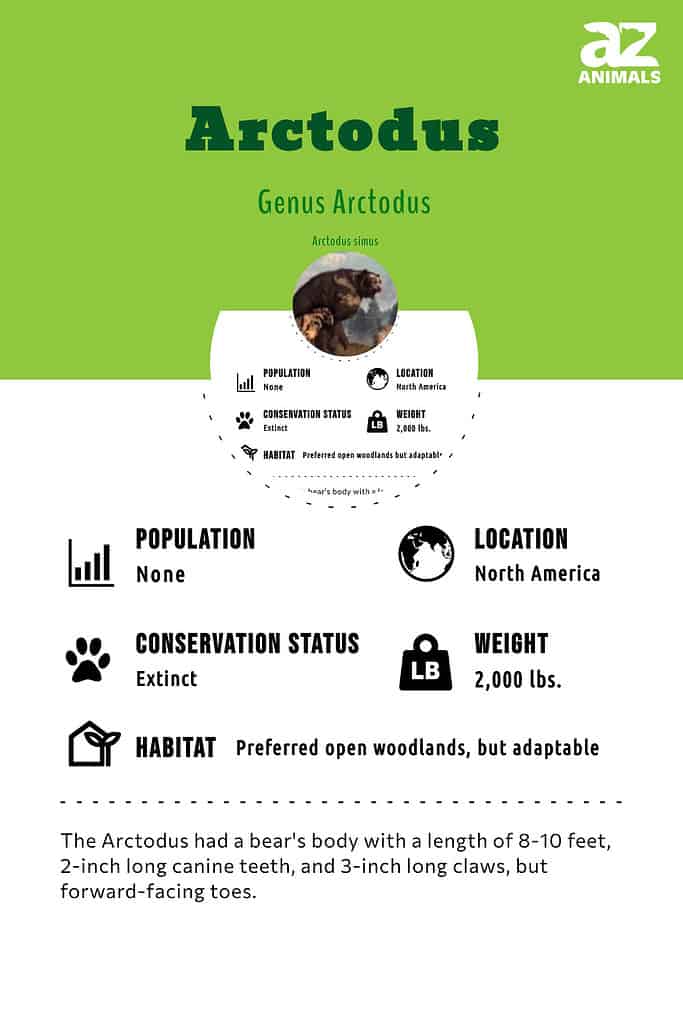
Scientific Classification and Name
The Arctodus, being a bear, belongs to the Family Ursidae. It also belongs to the Subfamily Tremarctinae. The genus Arctodus is now extinct, but it had two species:
- Lesser short-faced bear (Arctodus pristinus)
- Giant short-faced bear (Arctodus simus)
The Greek word Arctodus means bear tooth. The Latin word “pristinus” means early, or original, or primitive. The word simus translates to snub-nosed.
Ancestors of the Arctodus in the Subfamily Tremarctinae appeared in North America during the Miocene period, 23-5.3 million years ago. The genetic divergence that led to the Arctodus occurred about 5.5 million years ago.
Extinction
Paleologists are not sure about the reason behind this animal’s extinction. However, it is thought that A. pristinus became extinct about 300,000 years ago because of climate change and competition for food with other ursids. A. simus died out about 12,000 years ago, likely because of an ecological collapse depriving Arctodus of prey and vegetation.
More specifically, one theory says that when the ancient Clovis people moved into North America, they used a particular type of spear to kill the large prey eaten by the Arctodus. As its prey disappeared, the population of the Arctodus decreased as well. A second theory is that the glaciation in the Pleistocene age killed off the Arctodus along with many other types of animals.
Description and Size
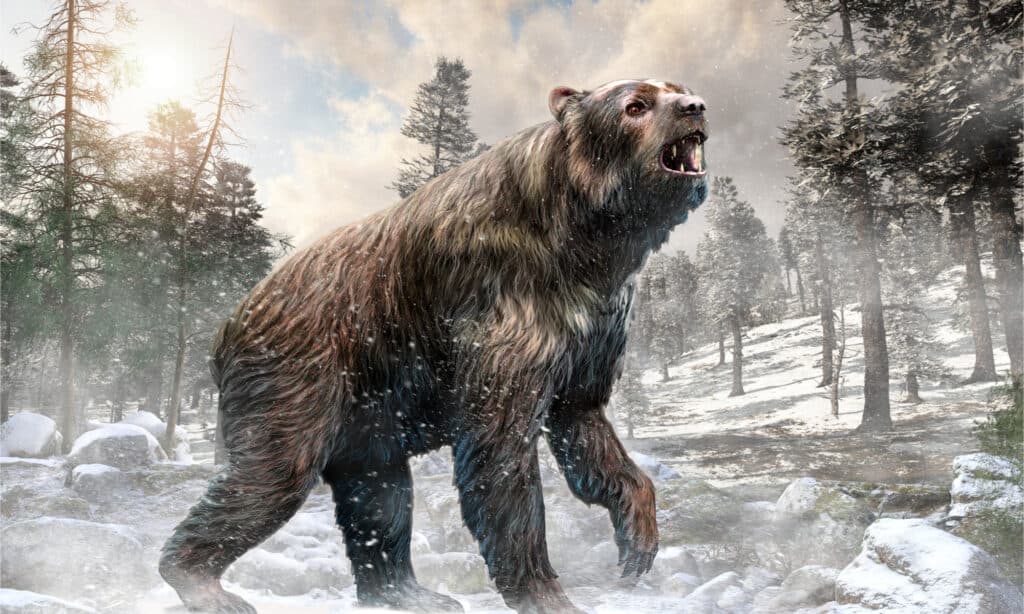
The Arctodus was believed to weigh 2,000 pounds or, perhaps, much more.
©Warpaint/Shutterstock.com
Study a drawing or re-created furry model of an Arctodus, and you may think you’re looking at a bear living at your local zoo. This bear did have a lot in common with the bears of today, but the Arctodus is extinct. The South American spectacled bear is its closest relative living today.
The Arctodus was an incredibly large animal with a typical weight of one ton (2,000 lbs.). However, some newly discovered fossil evidence has given paleontologists a reason to think these animals were even larger. The length of the Arctodus is estimated between eight and ten feet. So, when the Arctodus decided to stand on its hind legs, it would probably have looked a lot like a grizzly bear standing up to ten feet tall! When walking on all four feet, an Arctodus was about five to six feet tall at its shoulder. Remembering that an adult man is around six feet tall gives you a better picture of the size of an Arctodus.
Its canine teeth were likely at least two inches long, with strong molars used to ground up its prey.
The toes of the Arctodus are another notable feature of this bear. The toes face forward while the toes of bears living today are directed inward. Paleontologists aren’t sure about the reason behind this difference. The strong claws of this bear have been estimated at three inches in length.
The eyes of the Arctodus were set wide apart. You can get a better idea of this by looking at a picture of a spectacled bear. This gave the Arctodus excellent vision for finding its prey and pursuing it through various environments.
Paleontologists who’ve worked to re-create the full appearance of an Arctodus have given it light brown to black fur with grayish-white fur on its face and rounded ears.
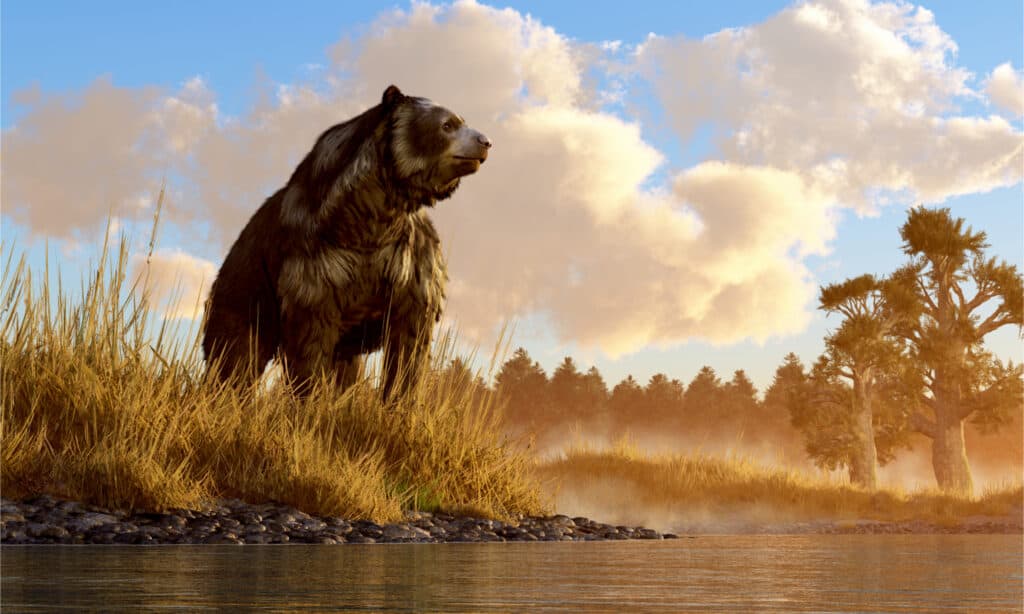
The Arctodus had a snub nose, which is why it is also referred to as a bulldog bear.
©Daniel Eskridge/Shutterstock.com
An Arctodus summary:
- Weight: 2,000 pounds or more
- Height: 5 to 6 feet at the shoulder
- Length: 8 to 10 feet
- Teeth: 2 inches or more in length
- Claws: 3 inches long
Diet
With its large canine teeth and powerful molars, you’ve probably already guessed that the Arctodus was a carnivore. You’re right! So, what did the Arctodus eat? They are believed to have eaten large prey such as dire wolves, bison, horses, and American cave lions. The Arctodus had very strong jaws capable of crushing bone, so large mammals were not a problem to break apart and digest.
The Arctodus had a couple of secret weapons it used when hunting the dire wolf, American lion, and other large mammals. For one, this ancient bear had a superb sense of smell that it used to track down its prey. In addition, the Arctodus was believed to travel at speeds of 40 mph so it could pursue its prey with great success.
Paleontologists believe the Arctodus was not only a hunter, but also a scavenger; in other words, it ate prey killed and left behind by other animals.
Habitat
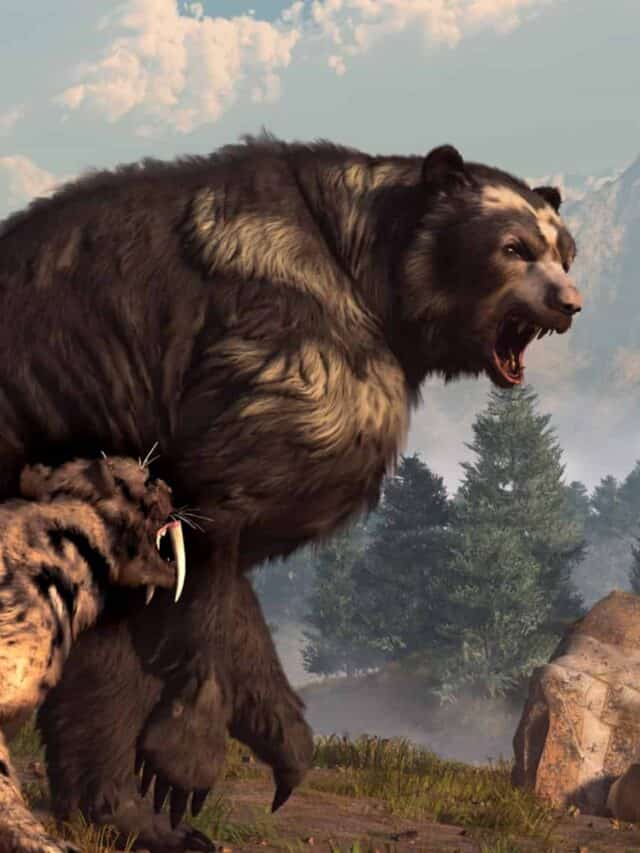
The Arctodus lived all over North America during the Pleistocene Age.
©Daniel Eskridge/Shutterstock.com
The Arctodus lived in the early to the middle part of the Pleistocene age. Evidence of this animal has been found throughout North America.
There’s evidence that large numbers of the lesser short-faced bear lived on the eastern coast of the United States as well as down into Mexico. Alternatively, there’s evidence giant short-faced bears lived in the northern part of the United States as well as in the western part, especially California, extending into Alaska. In general, these animals didn’t stay in one area throughout their lives. Paleontologists know this because bones and fossils have been found all around North America.
Countries where Arctodus once lived:
Threats and Predators
The Arctodus was a large animal with powerful jaws so it’s not surprising it had few to zero predators in some areas. However, one of the threats to the existence of the Arctodus was loss of food. The large prey eaten by this ancient bear was being killed off, leaving it to compete with other animals for a decreasing food supply.
Discoveries and Fossils
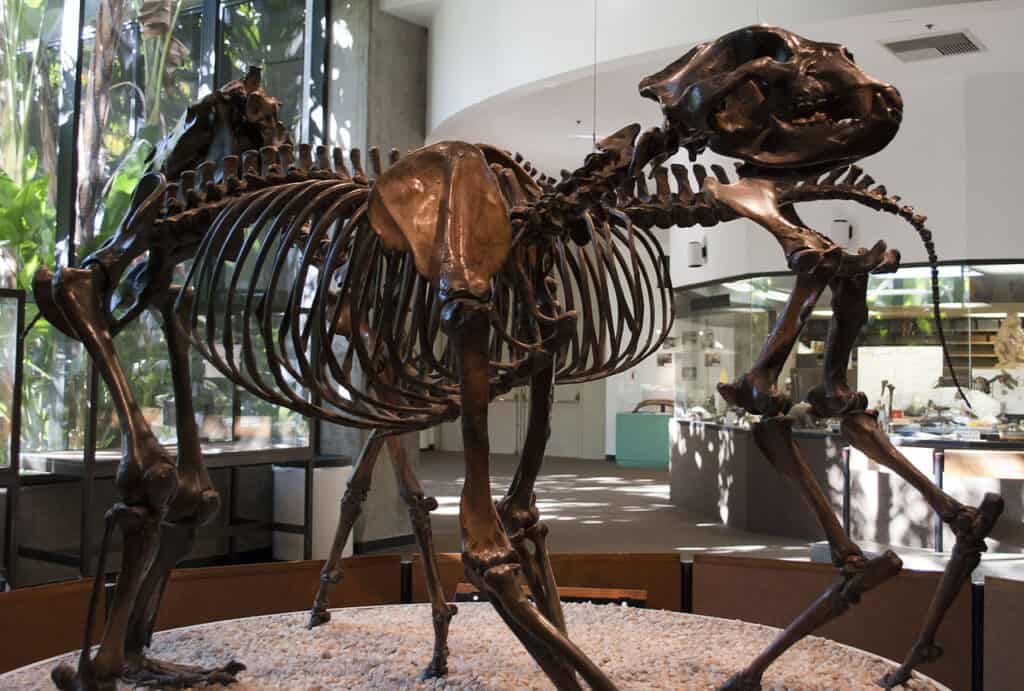
A skeleton of an Arctodus
simusrecreated from fossils.
©Riku64 / CC BY-SA 3.0 – License
The first discovery of Arctodus fossils dates back to 1854. A paleontologist named Joseph Leidy found Arctodus fossils in South Carolina specifically in the Ashley Phosphate Beds. Interestingly, just recently in March 2021, a diver found a three-inch tooth of a giant short-faced bear while diving in Cooper River in South Carolina. In short, discoveries concerning the Arctodus are still being made!
In 1967, large sections of a giant short-faced bear’s skeleton were discovered in a shallow lake in Fulton County in the state of Indiana. This is the most notable and complete discovery of Arctodus bones to date.
Another notable and relatively recent discovery of Arctodus bones occurred in 2008 in Iowa. In fact, it was the first Arctodus bone found in the state. A farmer in Iowa noticed a very large bone in a dam near Troublesome Creek. He took the bone to the Department of Agriculture where an archaeologist put it through several tests. Eventually, the bone was identified as a tibia and part of a pelvis from a giant short-faced bear. This exciting discovery adds to the expansive territory of this bear from the Ice Age. Can you imagine finding an Arctodus bone where you live?
Similar Animals
Animals similar to the Arctodus include:
- Jefferson ground sloth: At eight to ten feet long and 2200 pounds, this Ice Age ground sloth was similar in length and weight to the Arctodus.
- South American short-faced bear: This South American bear shares a similar facial appearance and tremendous size with the Arctodus found in North America. However, the South American short-faced bear was larger, weighing up to 3,858 pounds.
- Cave bear: At well over nine feet in length, the cave bear living in the Pleistocene Epoch was similar in size to the Arctodus.
- Tyrant polar bear: This Ice Age polar bear relative shares its huge size with the Arctodus. The Tyrant polar bear was believed to be over 11 feet long and weighed 2200 pounds.
Arctodus FAQs (Frequently Asked Questions)
When did the Arctodus live?
The Arctodus lived in the early to mid-part of the Pleistocene age.
How big was the Arctodus?
Paleontologists believe the Arctodus weighed 2,000 pounds or even more. They were thought to be five to six feet tall at the shoulder and eight to ten feet in length.
Paleontologists believe the Arctodus weighed 2,000 pounds or even more. They were thought to be five to six feet tall at the shoulder and eight to ten feet in length.
Paleontologists have at least two theories as to the reason behind the extinction of the Arctodus. One of those theories involves the Clovis people. The Clovis people moved into the territory of the Arctodus and began using weapons in the form of spears to kill large mammals. Many of those mammals were a food source of the Arctodus. So, with a decreasing supply of food, the Arctodus began to die off until it became extinct.
Another theory is the glaciation in the Pleistocene age killed off the Arctodus along with many other types of animals living at that time.
Despite these theories, paleontologists are not in agreement as to what caused the extinction of the Arctodus.
What is the largest bear that ever lived?
The prize for the largest bear that ever lived does not go to the Arctodus. That award goes to the Arctotherium angustidens. This ancient bear is believed to have lived in South America during the Pleistocene age. Paleontologists believe it weighed up to a whopping 3,500 pounds! This made the Arctotherium angustidens larger than today’s polar bears and Kodiak bears.
Are cave bears extinct?
Yes, cave bears are extinct. But remember, though both cave bears and Arctodus share some similarities, they were two different animals.
How fast was the Arctodus?
Paleontologists believe the Arctodus was capable of speeds of around 40mph. The grizzly bears of today have been clocked at a running speed of 30mph.
Thank you for reading! Have some feedback for us? Contact the AZ Animals editorial team.
Sources
- Florida Museum, Available here: https://www.floridamuseum.ufl.edu/florida-vertebrate-fossils/species/arctodus-pristinus/
- NPS, Available here: https://www.floridamuseum.ufl.edu/florida-vertebrate-fossils/species/arctodus-pristinus/
- Bear, Available here: https://www.floridamuseum.ufl.edu/florida-vertebrate-fossils/species/arctodus-pristinus/
- Riverbluff Cave, Available here: https://www.floridamuseum.ufl.edu/florida-vertebrate-fossils/species/arctodus-pristinus/
- NPS, Available here: https://www.floridamuseum.ufl.edu/florida-vertebrate-fossils/species/arctodus-pristinus/
- Ice Age Museum, Available here: http://iceage.museum.state.il.us/mammals/american-lion-0
- University of Iowa Museum of Natural History, Available here: https://mnh.uiowa.edu/giant-short-faced-bear
- Prehistoric Fauna, Available here: https://prehistoric-fauna.com/Megalonyx-jeffersonii
- Wikipedia, Available here: https://en.wikipedia.org/wiki/Cave_bear

















